#Research on your own!!!!
Text
So, remember a few posts ago when I made up a game to go outside and identify every tree I see, but I had to give it up because it's February? And nothing has leaves? I remembered later this doesn't apply to evergreens! Evergreens are still out there, and actually much more easy to point out, now that everything else is bare.
So. This is the knowledge I gathered from various sources from the internet!
Pines have long needles and they grow together in bunches, their silhouette is rounded at the edges, distinct and easy to recognize.
Spruce's branches are always pointed up, and grow upwards. Their needles grow in all directions out of the branches. Their needles also have 4 sides to them, and are easy to roll between fingers.
Fir's needles grow only to the left and right, and leave the middle of the branch exposed. The back of the needles have 2 white lines. Their lower branches point down.
Yew's needles are soft to touch, their color is more vibrant than the other evergreens, they grow red berries on them. Their needles also only grow from the sides, and not in the middle. Yew is the poisonous one that must not be mistaken for the rest!
With this info in my mind, I set off! This is the first evergreen tree I found, right in front of the building. I never tried to figure out what it was before.
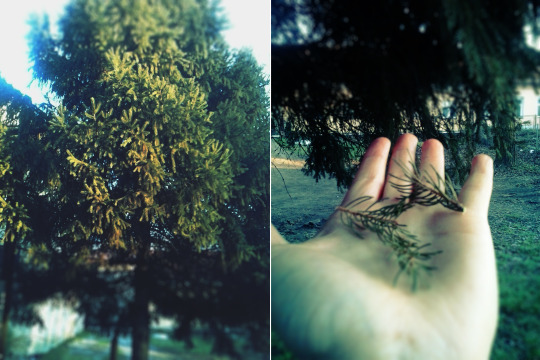
It looks majestic. What I can see here, is needles growing in every direction from the little tip I took off, so I decided it has to be spruce.
The next tree I noticed was in someone's backyard, but I wouldn't let that deter me! It was big and noticeable from far away! So. I sneaked in to take a picture:

Isn't it beautiful? This one also has needles growing from all directions, so it has to be another spruce. But, this one also has some tiny cones growing? I noted that as interesting, and moved on to the next.
Then I saw these two in people's backyard:
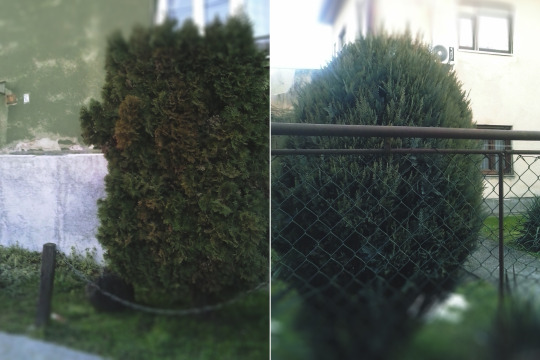
And I thought, well what are these? At first I thought, cypress, but these are obviously two different things, and they seem to be bushes at that, and I didn't research any bush varieties, so I had to let that go for now. If anyone can tell me their names I would love that!
And then I found lots more of similar trees!

They were definitely planted for decoration, and they're planted all together, but some of them have kind of a purple berry (cone?) growing on them, while some don't, and I'm not sure if they're the same species. Though I do think sometimes trees will grow their fruit only from the side that is more exposed to the sun, so it's possible the branches without berries are just underexposed to the light.
So the next several trees I found were spruces, or so it seems. I'm starting to get suspicious, because first, why didn't I know we were in a spruce-supremacy biome, second, why do all of these trees look so different? Look at them:

Look how janky some of them look! That is fun! Is that really a spruce? They all had needles growing in all directions, and the tips of their branches pointing up, but I'm starting to get suspicious and feel like these are different varieties of trees and we just called them all 'spruce' and moved on.
Then I, on purpose, went to the place with pines, where I usually harvest my pine needles for tea. This is, one of the most beautiful pines in the city:

This is not even a good picture of her, this being is divine. She's about the only thing that makes this place livable, every time I see her I'm astounded and filled with awe, she's so gorgeous and lush and perfect? Her shape? The feeling of being closer to heaven when you look at her? She has it all. I don't even know how they made that gorgeous tree grow next to such an ugly building. Anyway.
Close by is a little park made out of pine trees, I was able to find a little pine cone! And here are the pine needles:
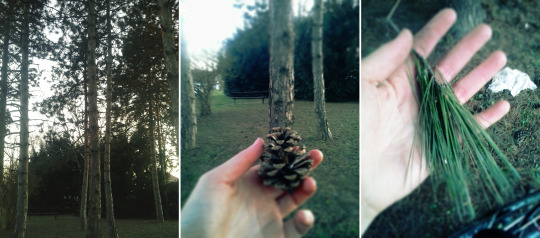
These can be eaten, added into meals, they can be made into syrups, tinctures, and they make a very calming tea! You can also weave a basket with them, which I did once! Blessed source of life.
Spruce and Fir needles are also edible and medicinal, but I've never tried them, so I'm not gonna talk about that yet. But here's whats NOT edible. The deadly yew tree:
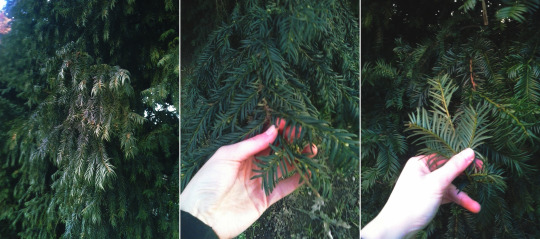
She's so soft to touch, it's almost impossible not to recognize. If you touch an evergreen and it's super soft and pliable, do not eat it! She's also beautiful and vibrant with her colors, I took pictures of this tree before, just because it was so pretty. You can see the needles also grow only on the sides, and not in every direction like the spruce.
And then, I noticed this tree from the road, and it was Different from all of the others. Firstly, it was growing new shoots, which most of the others were not into. Second, it looked super lush and healthy. I couldn't back out further to take a better picture because of the cars behind me, but I grabbed a little shoot, and checked it.

And see these needles how they're only growing to the sides, and not from the middle? And when you turn the needles on the other side, I know you can't see it, but there were 2 white lines on them! I've found a Fir!
That was the first, and the only fir I've found. I was so happy, relieved, and thrilled to find, all 4 evergreen species in walking distance of my residence. I also was pleased to know that my methods of recognition were true, firs really do have white lines on the underside of needles. Who knew!
Now, these are not all of the trees I've found, but the rest I found only gave me more questions than answers. I've found some baby spruces that looked completely different, like this:

And while I do find these adorable, I wanna know why are they so different? Is it because they're tiny? They look more lush and healthy, is it because they're cared for or they're different, imported species? Why is that last tree in the middle of cone production, while the other spruces are after different businesses? If this is a matter of different varieties then I'm personally offended nobody explained this to me.
Also, I found this bush? And it smelled? Incredible??
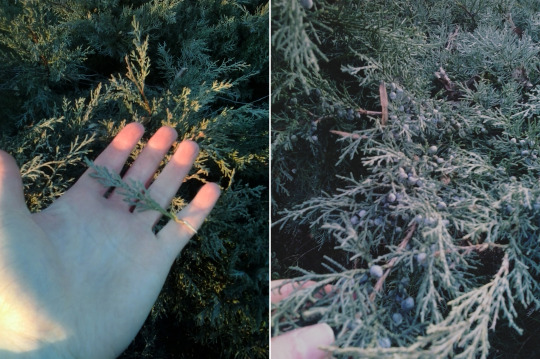
The scent of this was thousandfold the power of any other plant. Smelling this transported me into a thousand old forest and underground. After touching this, my entire hand smelled like it for the rest of my trip, I could smell nothing else. It was pine-like but also plant like, and deeper, stronger, like I was smelling not the ends of the plant but the middle of a tree, the center, the roots and the soil. I took a bit of it home to smell. I think it will do me good. Further research revealed that this is a juniper bush, well known for its intense and overpowering scent!
I'm happy to report that this tree ID mission has cured my anxiety for the day, made me feel like a sneaky little secret scientist, gave me special inside knowledge of the evergreen tree society around me and had me meet some awesome trees! I also found some I didn't even know were growing close to me. I looked into making the syrup from the needles, but found out it required outrageous amount of sugar, so I gave up on it. I'm going to use little branches and shoots I took to make tea out of all of the edible plants instead.
#evergreen trees#fir#pine#spruce#yew#tree ID game#juniper bush#don't take this as educational tool#i'm an amateur my information is surface level here#i'm just pointing finger saying Tree!!!#Research on your own!!!!#I will however completely trust my conclusions and drink tea from all of the needles hehehehehe#except yew i dont wanna die#this was such a fun time outside#and i learned a lot#i can't wait to go ID more trees
57 notes
·
View notes
Text
1963 Refrigerator 🤔
#pay attention#educate yourselves#educate yourself#knowledge is power#reeducate yourself#reeducate yourselves#think about it#think for yourselves#think for yourself#do your homework#do some research#do your own research#ask yourself questions#question everything#american history#history lesson
66K notes
·
View notes
Text
"aphobia doesn't exist"
bitch literally not that long ago an aroace youtuber animator was insulted by almost half of its community for being it
#i did some research about it and found out that the problem was principally that she had previous experience in the romantic area#so people just didn't take her seriously and said she was lying#even though she stated multiple times that she wasn't comfortable in those situations#now things are more calmed but damn#mind your own bussiness#i believe she knows more about herself than you#sorry if i offended you with this comment but i hate how aro/ace/aroace people are always left behind#insulted and rejected because they “dont know what they are talking about”#or because they “just have to wait for the right person”#or because they are “psychopaths and they are missing something”#i love that animator and she helped me realise a lot about myself#and now that i know the context i think i will start making a list and killing aphobes one by one#aromantic#arospec#asexual#aroace#acespec
9K notes
·
View notes
Text
AO3 Ship Stats: Year In Bad Data
You may have seen this AO3 Year In Review.

It hasn’t crossed my tumblr dash but it sure is circulating on twitter with 3.5M views, 10K likes, 17K retweets and counting. Normally this would be great! I love data and charts and comparisons!
Except this data is GARBAGE and belongs in the TRASH.
I first noticed something fishy when I realized that Steve/Bucky – the 5th largest ship on AO3 by total fic count – wasn’t on this Top 100 list anywhere. I know Marvel’s popularity has fallen in recent years, but not that much. Especially considering some of the other ships that made it on the list. You mean to tell me a femslash HP ship (Mary MacDonald/Lily Potter) in which one half of the pairing was so minor I had to look up her name because she was only mentioned once in a single flashback scene beat fandom juggernaut Stucky? I call bullshit.
Now obviously jumping to conclusions based on gut instinct alone is horrible practice... but it is a good place to start. So let’s look at the actual numbers and discover why this entire dataset sits on a throne of lies.
Here are the results of filtering the Steve/Bucky tag for all works created between Jan 1, 2023 and Dec 31, 2023:

Not only would that place Steve/Bucky at #23 on this list, if the other counts are correct (hint: they're not), it’s also well above the 1520-new-work cutoff of the #100 spot. So how the fuck is it not on the list? Let’s check out the author’s FAQ to see if there’s some important factor we’re missing.
The first thing you’ll probably notice in the FAQ is that the data is being scraped from publicly available works. That means anything privated and only accessible to logged-in users isn’t counted. This is Sin #1. Already the data is inaccurate because we’re not actually counting all of the published fics, but the bots needed to do data collection on this scale can't easily scrape privated fics so I kinda get it. We’ll roll with this for now and see if it at least makes the numbers make more sense:

Nope. Logging out only reduced the total by a couple hundred. Even if one were to choose the most restrictive possible definition of "new works" and filter out all crossovers and incomplete fics, Steve/Bucky would still have a yearly total of 2,305. Yet the list claims their total is somewhere below 1,500? What the fuck is going on here?
Let’s look at another ship for comparison. This time one that’s very recent and popular enough to make it on the list so we have an actual reference value for comparison: Nick/Charlie (Heartstopper). According to the list, this ship sits at #34 this year with a total of 2630 new works. But what’s AO3 say?

Off by a hundred or so but the values are much closer at least!
If we dig further into the FAQ though we discover Sin #2 (and the most egregious): the counting method. The yearly fic counts are NOT determined by filtering for a certain time period, they’re determined by simply taking a snapshot of the total number of fics in a ship tag at the end of the year and subtracting the previous end-of-year total. For example, if you check a ship tag on Jan 1, 2023 and it has 10,000 fics and check it again on Jan 1, 2024 and it now has 12,000 fics, the difference (2,000) would be the number of "new works" on this chart.
At first glance this subtraction method might seem like a perfectly valid way to count fics, and it’s certainly the easiest way, but it can and did have major consequences to the point of making the entire dataset functionally meaningless. Why? If any older works are deleted or privated, every single one of those will be subtracted from the current year fic count. And to make the problem even worse, beginning at the end of last year there was a big scare about AI scraping fics from AO3, which caused hundreds, if not thousands, of users to lock down their fics or delete them.
The magnitude of this fuck up may not be immediately obvious so let’s look at an example to see how this works in practice.
Say we have two ships. Ship A is more than a decade old with a large fanbase. Ship B is only a couple years old but gaining traction. On Jan 1, 2023, Ship A had a catalog of 50,000 fics and ship B had 5,000. Both ships have 3,000 new works published in 2023. However, 4% of the older works in each fandom were either privated or deleted during that same time (this percentage is was just chosen to make the math easy but it’s close to reality).
Ship A: 50,000 x 4% = 2,000 removed works
Ship B: 5,000 x 4% = 200 removed works
Ship A: 3,000 - 2,000 = 1,000 "new" works
Ship B: 3,000 - 200 = 2,800 "new" works
This gives Ship A a net gain of 1,000 and Ship B a net gain of 2,800 despite both fandoms producing the exact same number of new works that year. And neither one of these reported counts are the actual new works count (3,000). THIS explains the drastic difference in ranking between a ship like Steve/Bucky and Nick/Charlie.
How is this a useful measure of anything? You can't draw any conclusions about the current size and popularity of a fandom based on this data.
With this system, not only is the reported "new works" count incorrect, the older, larger fandom will always be punished and it’s count disproportionately reduced simply for the sin of being an older, larger fandom. This example doesn’t even take into account that people are going to be way more likely to delete an old fic they're no longer proud of in a fandom they no longer care about than a fic that was just written, so the deletion percentage for the older fandom should theoretically be even larger in comparison.
And if that wasn't bad enough, the author of this "study" KNEW the data was tainted and chose to present it as meaningful anyway. You will only find this if you click through to the FAQ and read about the author’s methodology, something 99.99% of people will NOT do (and even those who do may not understand the true significance of this problem):


The author may try to argue their post states that the tags "which had the greatest gain in total public fanworks” are shown on the chart, which makes it not a lie, but a error on the viewer’s part in not interpreting their data correctly. This is bullshit. Their chart CLEARLY titles the fic count column “New Works” which it explicitly is NOT, by their own admission! It should be titled “Net Gain in Works” or something similar.
Even if it were correctly titled though, the general public would not understand the difference, would interpret the numbers as new works anyway (because net gain is functionally meaningless as we've just discovered), and would base conclusions on their incorrect assumptions. There’s no getting around that… other than doing the counts correctly in the first place. This would be a much larger task but I strongly believe you shouldn’t take on a project like this if you can’t do it right.
To sum up, just because someone put a lot of work into gathering data and making a nice color-coded chart, doesn’t mean the data is GOOD or VALUABLE.
#ao3#ao3 stats#psa#my words#fandom#I doubt anyone is even going to read this but I needed to get it out of my system and at least try to stop this from spreading#if you know me#you know I get Big Mad about misinformation#don't take anything at face value#do your own research
2K notes
·
View notes
Text
*sigh*
I'm seeing variations of this meme around again, so to today's (un)lucky 10000:
the "inside you there are two wolves" meme is racist. full stop. it was invented by a Christian pastor in the late 70s and attributed to the Cherokee nation, despite being completely made up. every native american / indigenous page I've ever followed denounces it as made up and racist, using their imagery to sound mystical and wise while ignoring the people themselves.
please consider using another format. try to use your guilt productively: I'm not calling you out, this is aimed at educating. You can't erase not knowing in the past, but you can elect to 1) not reblog these in the future, 2) delete any that are easy to delete, 3) help to spread education by following native people's accounts and news so that you hear this from them, not me.
#there is some 'debate' about the origins on the internet but i'm gonna be real:#when i can't find even one person who claims to be native who says it isn't racist and made up... it's racist and made up#do your own research but just... try to listen to the least heard voices and not just those trying to boost them#i'd go find a post on it from a native account but i am currently researched out due to IRL stuff i don't plan to talk about
2K notes
·
View notes
Text
i’m so sick of writers who proudly proclaim that they don’t read and directors and actors and other filmmakers who smugly say that they rarely watch movies or any artist who acts like an audience is stupid for connecting with their work like what the fuck is wrong with you that you hold such contempt such derision for the art that you have chosen to make the art that so many people dream of the opportunity to make the art that brings meaning and connection to people’s lives it’s unbelievably disrespectful to both your audience and the art-form and if you can’t muster basic respect for either your art-form or your audience then kindly fuck off and do something else
#i hate how rare it is to have an actor be like ‘yeah i just really love movies and going to the movies it’s the best i love what i do’#to the point where when an actor or director IS like that people are like ‘wow what a freak…they’re faking it for attention’ like!! no!!#that’s what it’s SUPPOSED TO BE LIKE!! you WANT creators who are obsessed with their medium!!!#and what gets me about the people who don’t feel that way is the clear Pride they feel like they’re Better for not caring#that uk ya author adapting the odyssey and admitting that they’ve never read the odyssey or the iliad#that writer on twitter saying that telling writers to read is ableist#the russo brothers saying that the theatrical experience is elitist and auteurism should bow to the disney/netflix model#christain bale and any number of other actors who proudly announce that they don’t watch movies#sam levinson who talks about tv like it’s a long movie because he can’t hack it as a filmmaker like his dad but he doesn’t actually LIKE tv#like i get not wanting to consume your own work after it’s released unless it’s for research or self reflection purposes#but you do not exist or create in a vacuum and it’s SO disrespectful and arrogant to act like you do
29K notes
·
View notes
Text
Low level/continuous pain tips for writing
Want to avoid the action movie effect and make your character's injuries have realistic lasting impacts? Have a sick character you're using as hurt/comfort fodder? Everyone has tips for how to write Dramatic Intense Agony, but the smaller human details of lasting or low-level discomfort are rarely written in. Here are a few pain mannerisms I like to use as reference:
General
Continuously gritted teeth (may cause headaches or additional jaw pain over time)
Irritability, increased sensitivity to lights, sounds, etc
Repetitive movements (fidgeting, unable to sit still, slight rocking or other habitual movement to self-soothe)
Soft groaning or whimpering, when pain increases or when others aren't around
Heavier breathing, panting, may be deeper or shallower than normal
Moving less quickly, resistant to unnecessary movement
Itching in the case of healing wounds
Subconsciously hunching around the pain (eg. slumped shoulders or bad posture for gut pain)
Using a hand to steady themself when walking past walls, counters, etc (also applies to illness)
Narration-wise: may not notice the pain was there until it's gone because they got so used to it, or may not realize how bad it was until it gets better
May stop mentioning it outright to other people unless they specifically ask or the pain increases
Limb pain
Subtly leaning on surfaces whenever possible to take weight off foot/leg pain
Rubbing sore spots while thinking or resting
Wincing and switching to using other limb frequently (new/forgettable pain) or developed habit of using non dominant limb for tasks (constant/long term pain)
Propping leg up when sitting to reduce inflammation
Holding arm closer to body/moving it less
Moving differently to avoid bending joints (eg. bending at the waist instead of the knees to pick something up)
Nausea/fever/non-pain discomfort
Many of the same things as above (groaning, leaning, differences in movement)
May avoid sudden movements or turning head for nausea
Urge to press up against cold surfaces for fever
Glazed eyes, fixed stare, may take longer to process words or get their attention
Shivering, shaking, loss of fine motor control
If you have any more details that you personally use to bring characters to life in these situations, I'd love to hear them! I'm always looking for ways to make my guys suffer more write people with more realism :)
#voidrambles#writing#whump#does this count as that? whatever those folks will probably enjoy it at any rate#this is honestly mostly for my own reference but i hope it can maybe help some other people too :)#I'm so pulled in by books that write pain in a human and detailed way and not just when it's dramatic or intense#would love to see more of that and incorporate it into my own writing#oh i should have added. distraction seeking to that list#like writing a really long post about.#...yes i may be chronically ill and having a flare today and yes i may be farming myself for writing tips for Future Me hdgfhfhsjs#but hey gotta do your research somewhere babeyyy it all goes in the creativity soup#tw injury#tw illness
8K notes
·
View notes
Photo
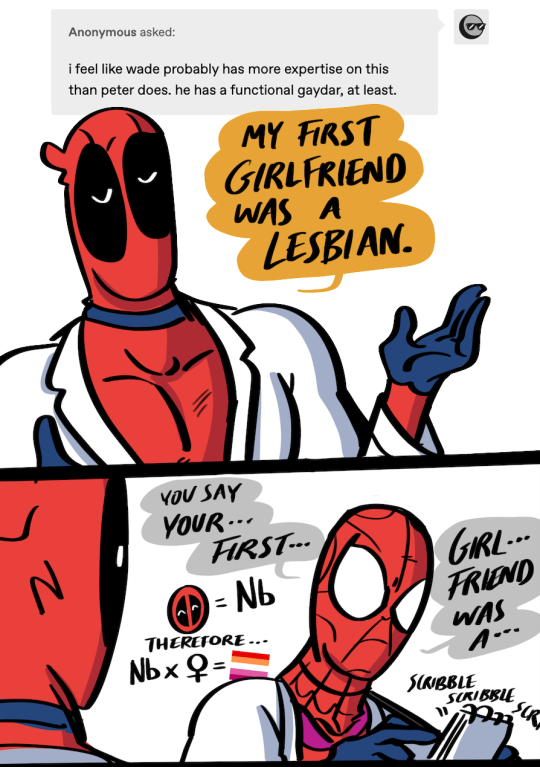

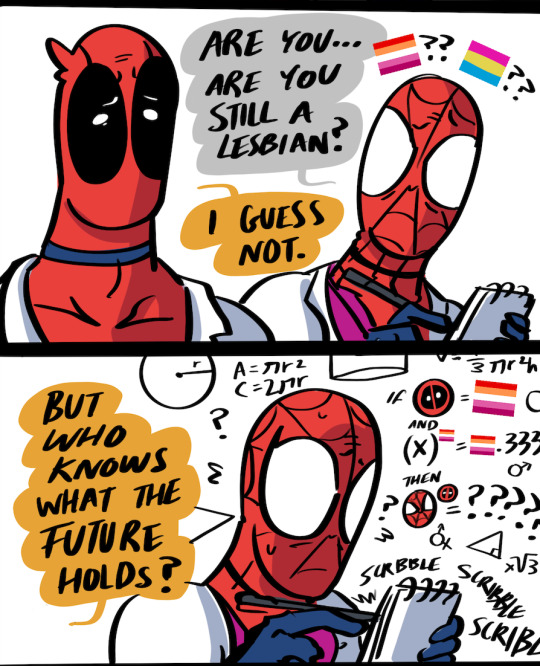
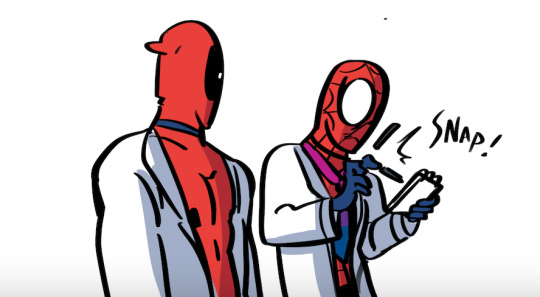
#ask-spiderpool#actually they're both idiots.#spideypool#main#i hope nobody takes these posts too seriously#these stupid little guys can't tell you how to label yourselves or what those labels mean to you personally#it's good for you to do your own research and experimentation and talk to people in those circles who can help you in your journey!
4K notes
·
View notes
Text

soulmark au sketches. the idea of sokka in proven ‘soulmates are real’ universes consistently intrigues me—how would that impact his skepticism/interpretation of fate/destiny/free will? personally i think he’d be very angry for a very long time and probably not even understand why
#my art#it’s just a ‘important moments in your soulmates life show up on u through kinda vague occasionally metaphorical marks#fuck i love soulmate aus lol#the clothes lean a lil fire nation/earth kingdomy i think but i was just riding the high of drawing#knowing if i stopped to do research i might just. stop entirely#so i just winged it#wung it. u could even say#anyways#sokka#avatar the last airbender#zukka#soulmate au#i imagine that in this au sokka zuko and probably aang all get matching ‘avatar beam of light!’ soulmarks#just giant white-blue beams all the way up their arm or leg or torso or somethin#cuz like. life changing moment for each of them lol#katara would get like. her own eyes or something representing her eye color for the moment aang wakes up and sees her#lol just saw i forgot to color his mouth in the first sketch lol
640 notes
·
View notes
Text
Ethnic cleansing? Genocide? Apartheid?
Throwing around these buzzwords to describe the Israel-Hamas war because you’ve seen them on social media doesn’t make you right, and it doesn’t make you an activist.
It makes you ignorant, intellectually dishonest, and lazy for parroting biased talking points with no concept about what these terms actually mean.
What is apartheid?
Well, it was first used to describe the political system in South Africa and today’s Namibia whereby racism was institutionalised. This manner of governance meant that clear racial segregation would occur, in a manner that benefited the white race and would actively oppress those who had darker skin.
This meant that there were white-only spaces, white people would get prioritised when it came to education and jobs, and relationships/marriages between white peoples and coloured people were illegal.
Is Israel objectively an apartheid state? There are no laws that actively favour one group over the other. There is a sizeable population of Israeli Arabs that can thrive in the same way as the Israeli Jews can. There are laws against discrimination on the basis of gender, race/ethnicity, and sexual orientation.
Palestinians from Gaza are allowed to work in Israel through a work permit system. There are about 150,000 Palestinians working in Israel, most of which live in Israel and some come from Gaza/the West Bank. They aren’t denied rights institutionally.
Is it harder to get a job or education in Israel if you’re a Palestinian from Gaza? Sure, because of different governments. It’s like how it’s a lot easier for you to find a job in your own country (in terms of paperwork and bureaucracy) than overseas. But you’re not denied the right to apply.
Of course, if you have a history of violence, a criminal record, or your family has ties to terrorists, then it’ll be a lot harder to get an approved work permit. But that’s not apartheid. That’s common sense, and a regulation practiced by all countries that minimally desire to protect their own population from danger.
Ethnic cleansing and genocide
These two concepts can go hand-in-hand. Ethnic cleansing refers to the mass expulsion or killing of a group of people based on their ethnicity. Similarly, genocide is the purposeful killing of a group of people solely with the intention of annihilating them.
Famous examples? The Holocaust, of course, where the Nazi regime believed in the superiority of the Aryan race and decided to declare genocide on the Jews, Romanis, the LGBTQ+ community, people with disabilities, people with “Asian features”, and many many other groups. Anyone who they didn’t think was “pure”.
Their aim was to ensure that the Aryan race propagated without having “impure” blood affecting the bloodlines. They even started a eugenics programme called Lebensborn to ensure that more pure Aryan babies were born.
More recent examples? The Rwandan genocide where the Hutus attempted to wipe out the Tutsis on the basis of ethnicity. They mandated that Tutsis mention their ethnicity on state-issued ID cards in order for the Hutus in power to be able to identify them and then kill them.
Or the Yazidi genocide which happened so recently, in which ISIL killed, raped, and sent thousands of Yazidis into conversion camps on the basis of their ethnicity. They also took Yazidi women as sex slaves and raped and tortured them.
Or the Rohingya Muslims in the Rakhine State in Myanmar, and how there was a mass killing and expulsion of them from the country, forcing them to flee to Bangladesh to take refuge, crating the world’s largest refugee camp.
Or how ISIS killed thousands of people from Christian groups in Iraq, Syria, Egypt, and Libya because of their faith, leading the US, EU, and UK to label this as religious genocide and condemned their actions.
Has Israel been practicing ethnic cleansing and genocide on Palestinians all these years?
Well, the birth rate of the Palestinian population in Gaza, the West Bank, and in Israel has been steadily increasing all these years.
So, no. No ethnic cleansing, no genocide. They are free to have as many children as they desire.
The UN Genocide Convention
The United Nations has 5 actions that constitute genocide.
1. Killing members of a target group
Israel is targeting Hamas officials with the aim of wiping out the terrorist group and ensuring that such a deadly attack on Israeli soil doesn’t happen again. I suppose you could call it genocide against Hamas, but they’re killing Hamas because they’re terrorists, not because they’re Palestinian. Shouldn’t everyone believe in genocide against terrorists?
But look at Black Saturday. Look at Hamas’ rhetoric. They repeatedly call for the annihilation of Israel and genocide of Jews. When will the media start believing what they say, word for word, instead of trying to spin it into “hmm maybe they want to kill all the Jews because they’re freedom fighters!”
War has collateral damage. Of course the innocent civilians don’t deserve to suffer just because of the actions of their government, but there have been warnings given to the Palestinian civilians prior to Israel striking the areas. There are consequences of attacking a country first, and then having that country attack you back.
2. Causing people of the group serious bodily or mental harm
The UN refers to sexual violence as the prime example of non-fatal harm.
Sexual violence has occurred. Hamas have kidnapped and raped women and even paraded the bodies of half-naked women around. But I f Israel had done the same, it’ll be the first thing appearing on everyone’s BBC push notifications (without even being confirmed as true).
3. Imposing living conditions intended to destroy the group
Many people refer to the blockade that Israel imposed around the Gaza Strip as an example of this.
This blockade was imposed by both Israel and Egypt in 2005. Its aim was to prevent smuggling of weapons into Gaza, and isolate the reign of Hamas to the region. This was to ensure the safety of Israel and Egypt.
Did this blockade pose serious challenges to the Gazan civilians? Of course. But that’s a consequence of having a terrorist government. If you have a terrorist group running your country, don’t be surprised if neighbouring countries are extra careful about who or what they allow in or out of the borders.
Many authorities from other Arab nations have also expressed approval of Egypt’s border restrictions, and even encouraged Egypt to flood the terror tunnels that Hamas has dug under the city. As a side note, other Arab nations have not historically been very kind or welcoming to Palestinians. Syria has killed over 4000 Palestinians, and many Arab countries are now refusing any refuge for Palestinians. But no one cares about that because it doesn’t make Israel look bad. All they do now is use the images of dead Palestinians under the hands of Syria and reuse them to propagate fake news.
The blockade has been labelled as a human rights violation because of collective punishment. Many humanitarian organisations believe that the blockade has caused the Palestinian civilians disproportionate harm.
Contrary to popular belief, Israel isn’t disallowing humanitarian aid from coming through the borders. Fuel, food, hygiene products, clothes, and shoes have been coming through the borders regularly for years. The Gaza Strip also has electricity and internet access and water.
Do all these items reach the Palestinian civilians? Well, there has been evidence that Hamas has been intercepting a lot of the supplies sent by humanitarian groups. This is not surprising since the UNRWA tweeted that Hamas has stole fuel from hospitals in Gaza in order to launch more rockets at Israel (but quickly deleted it after realising that it goes against their agenda to paint Hamas in a bad light.) In addition, the returned hostages have mentioned that there are many aid supplies hidden in the terror tunnels by Hamas. Instead of giving them to the civilians, they are hoarding it for themselves.
There has also been video evidence that some people are reselling these aid items in stores at exorbitant prices in order to turn profits. This has been well-documented for the last 10 years.
Is blockading the region to mitigate terrorism a disproportionate response? Well, it’s like asking if heightened security and stricter border control at airports is a disproportionate response after 9/11. Is being cautious and worrying about the security of your country an irrational reaction to the constant threat of terrorism?
4. Preventing births
Gaza’s population growth rate per annum is about 1.99%, which is the 39th highest in the world! Their population is allowed to propagate freely.
Israel isn’t preventing births of Palestinian babies.
5. Forcibly transferring children out of the group
No, Israel hasn’t been taking Palestinian children and forcing them to convert/keeping young Palestinian girls as sex slaves. Like I said, if this was truly happening, all the news outlets would be so quick to publish the story before verifying it.
Can we trust the UN Genocide standards?
The UN is known for corruption and have been exploiting the Palestinian people by selling them the humanitarian supplies instead of distributing them for free, which they should because these supplies literally are donations.
The UN also has differing standards of what they would label as genocide. For example, they refuse to call what China is doing to the Uyghurs in Xinjiang as genocide, even though the situation does fit many of their own criteria.
Hence, to all of you out there overusing these terms without knowing what they mean, make up your own mind about things. No one can force you to believe anything and no one can force you to change your mind.
But at the very least, do your due diligence and educate yourself before spouting tired buzzwords. Repeating misinformation doesn’t help anyone and can be very harmful.
#i stand with israel#israel#palestine#gaza#stop hamas#pro israel#am yisrael chai#hamas#fuck hamas#hypocrisy#i support israel#using buzzwords doesn’t make you smart#do your homework#do your own research#unrwa is a scam#make up your own mind#reading Al Jazeera headlines isn’t education#media bias#call out fake news#stop fake news#stop anti semitism
929 notes
·
View notes
Text
Do Your Research
This phrase is regularly thrown around writeblr and for good reason. It's important to research what you are writing about to know what to include, what can be fudged, and how to depict whatever you're writing. I see "do your research" most thrown around by well-meaning and highly traditionally educated writers. It's solid advice, after all!
But how do you research?
For those writers who don't already have the research skills necessary to write something comfortably already downloaded into your brain, I put this guide together for you.
Where do I even start?
It's a daunting task, research. But the best place to start is with the most basic, stupidest question you can think of. I'm going to talk about something that I already know a lot about: fighting.
When researching fight scenes, a great way to start is to look up what different weapons are. There are tons out there! So ask the stupid questions. What is a sword? What is a gun? How heavy are they?
Google and Wikipedia can help you a lot with these basic-level questions. They aren't great sources for academic articles, but remember, this is fiction. It doesn't need to be perfect, and it doesn't need to be 100% accurate if you don't want it to be. But knowing what is true to life will help you write well. Just like knowing the rules of writing will help you break them.
You may find in your basic research sweep that you have a lot more specific questions. Write them all down. It doesn't matter if they seem obvious. Write them down because they will be useful later.
How To Use Wikipedia Correctly
Wikipedia is a testament to cooperative human knowledge. It's also easy to edit by anonymous users, which means there is a lot of room for inaccuracies and misleading information. Wikipedia is usually pretty good about flagging when a source is needed or when misleading language is obvious, but Wikipedia itself isn't always the most accurate or in-depth source.
Wikipedia is, however, an excellent collection of sources. When I'm researching a subject that I know nothing about, say Norse mythology, a good starting point is the Wikipedia page for Odin. You'll get a little background on Odin's name and Germanic roots, a little backstory on some of the stories, where they appear, and how they are told.
When you read one of the sentences, and it sparks a new question, write the question down, and then click on the superscript number. This will take you directly to the linked source for the stated fact. Click through to that source. Now you have the source where the claim was made. This source may not be a primary source, but a secondary source can still lead you to new discoveries and details that will help you.
By "source-hopping," you can find your way across the internet to different pieces of information more reliably. This information may repeat itself, but you will also find new sources and new avenues of information that can be just as useful.
You mean I don't need a library?
Use your library. Libraries in many parts of the US are free to join, and they have a wealth of information that can be easily downloaded online or accessed via hardcopy books.
You don't, however, need to read every source in the library for any given topic, and you certainly don't need to read the whole book. Academic books are different from fiction. Often their chapters are divided by topic and concept and not by chronological events like a history textbook.
For example, one of my favorite academic books about legislative policy and how policy is passed in the US, by John Kingdon, discusses multiple concepts. These concepts build off one another, but ultimately if you want to know about one specific concept, you can skip to that chapter. This is common in sociological academic books as well.
Going off of my Norse Mythology example in the last section, a book detailing the Norse deities and the stories connected to them will include chapters on each member of the major pantheon. But if I only care about Odin, I can focus on just the chapters about Odin.
Academic Articles and How To Read Them
I know you all know how to read. But learning how to read academic articles and books is a skill unto itself. It's one I didn't quite fully grasp until grad school. Learn to skim. When looking at articles published in journals that include original research, they tend to follow a set structure, and the order in which you read them is not obvious. At all.
Start with the abstract. This is a summary of the paper that will include, in about half a page to a page, the research question, hypothesis, methods/analysis, and conclusions. This abstract will help you determine if the answer to your question is even in this article. Are they asking the right question?
Next, read the research question and hypothesis. The hypothesis will include details about the theory and why the researcher thinks what they think. The literature review will go into much more depth about theories, what other people have done and said, and how that ties into the research of the present article. You don't need to read that just yet.
Skim the methods and analysis section. Look at every data table and graph included and try to find patterns yourself. You don't need to read every word of this section, especially if you don't understand a lot of the words and jargon used. Some key points to consider are: qualitative vs. quantitative data, sample size, confounding factors, and results.
(Some definitions for those of you who are unfamiliar with these terms. Qualitative data is data that cannot be quantified into a number. These are usually stories and anecdotes. Quantitative data is data that can be transferred into a numerical representation. You can't graph qualitative data (directly), but you can graph quantitative data. Sample size is the number of people or things counted (n when used in academic articles). Your sample size can indicate how generalizable your conclusions are. So pay attention. Did the author interview 300 subjects? Or 30? There will be a difference. A confounding factor is a factor that may affect the working theory. An example of a theory would be "increasing LGBTQ resources in a neighborhood would decrease LGBTQ hate crimes in that area." A confounding factor would be "increased reporting of hate crimes in the area." The theory, including the confounding factor, would look like "increasing LGBTQ resources in a neighborhood would increase the reporting of hate crimes in the area, which increases the number of hate crimes measured in that area." The confounding factor changes the outcome because it is a factor not considered in the original theory. When looking at research, see if you can think of anything that may change the theory based on how that factor interacts with the broader concept. Finally, the results are different from the conclusions. The results tell you what the methods spit out. Analysis tells you what the results say, and conclusions tell you what generalizations can be made based on the analysis.)
Next, read the conclusion section. This section will tell you what general conclusions can be made from the information found in the paper. This will tell you what the author found in their research.
Finally, once you've done all that, go back to the literature review section. You don't have to read it necessarily, but reading it will give you an idea of what is in each sourced paper. Take note of the authors and papers sourced in the literature review and repeat the process on those papers. You will get a wide variety of expert opinions on whatever concept or niche you're researching.
Starting to notice a pattern?
My research methods may not necessarily work for everybody, but they are pretty standard practice. You may notice that throughout this guide, I've told you to "source-hop" or follow the sources cited in whatever source you find first. This is incredibly important. You need to know who people are citing when they make claims.
This guide focused on secondary sources for most of the guide. Primary sources are slightly different. Primary sources require understanding the person who created the source, who they were, and their motivations. You also may need to do a little digging into what certain words or phrases meant at the time it was written based on what you are researching. The Prose Edda, for example, is a telling of the Norse mythology stories written by an Icelandic historian in the 13th century. If you do not speak the language spoken in Iceland in 1232, you probably won't be able to read anything close to the original document. In fact, the document was lost for about 300 years. Now there are translations, and those translations are as close to the primary source you can get on Norse Mythology. But even then, you are reading through several veils of translation. Take these things into account when analyzing primary documents.
Research Takes Practice
You won't get everything you need to know immediately. And researching subjects you have no background knowledge of can be daunting, confusing, and frustrating. It takes practice. I learned how to research through higher formal education. But you don't need a degree to write, so why should you need a degree to collect information? I genuinely hope this guide helps others peel away some of the confusion and frustration so they can collect knowledge as voraciously as I do.
– Indy
#writing advice#writing tips#writing resources#writeblr#amwriting#writblr#writers of tumblr#writers on tumblr#writing help#writing guide#how to research#reading research articles#do some research#do your own research#do your research#research for writers#writing research#writing tip#writing reference#writer tips
2K notes
·
View notes
Text
apparently another kid died at trails carolina
i'm not. gonna look into that claim for my own sanity but i swear to fuck if you don't know anything about the troubled teen industry, now is the time to learn
#swingset#tti#do not make any attempt to provide sources or information on this post. you will be blocked.#by all means make your own post with your own sources and research#but there's a reason i'm not looking into it on my own#i just. can't handle it rn
425 notes
·
View notes
Text
Old Lighters 🤔
#pay attention#educate yourselves#educate yourself#knowledge is power#reeducate yourself#reeducate yourselves#think about it#think for yourselves#think for yourself#do your homework#do some research#do your own research#ask yourself questions#question everything#old lighters#lighters#antique#history lesson#history#american history#world history#ancient history
19K notes
·
View notes
Text
People are out here talking about how they're never going to let me trans their children, as I haven't been chem-trailing the very air that they breathe for the last 20 years. Yeah, your book banning? Isn't going to do shit. If you want to stop me, you have to blow up the whole petrochemical industry, and patriots are all too weak and lazy for that.
925 notes
·
View notes
Text
"The most violent element in society is ignorance."
Emma Goldman.
#thought of the day#thought of today#emma goldman#violence#violent#elements#elements of society#society#ignorance#fight ignorance#awareness#blinkers#information#knowledge#overwiew#perception#perspective#understanding#be informed#do your own research#get wise#think ouside the box#think about it
2K notes
·
View notes
Text
Actually just curious :]
SYNESTHESIA is characterized as a 'cross wiring' of senses in your brain
for example
tasting words
Numbers and letters having personalities
and having a consistent link between colors and numbers/letters etc. This can be fully visual (seeing aura simmialr to migrains when hearing noises) or internal (imagining bright colors or shape/ number associations to things in your 'minds eye')
Diffrent days of the week having a strong color connection
Alternatively days of the week and calender months having a specific mental layout or 'shape' and days of the week and month having a specific place om this mental map that shifts depending on where you are in time, simmilar to a clock or time table
I'm also curious on how this effects you so you can leave that in the reblogs if your comfortable!
For me personally my synesthesia effects my writing because I'll often mix up letters and numbers ( I write down 4 alot instead of G and vice versa, I also mix up 4 and 7 because they 'look' the same, I'm wondering if this is some sort of dyscalculia though, the same thing happens with A and 8)
#dustbunnies.txt#polls#synesthesia#autism#actually autistic#adhd#you guys can do your own research#but personally i have grapheme color synesthesia and music/color/shape association. idk what that about lol#off the top of my head
759 notes
·
View notes